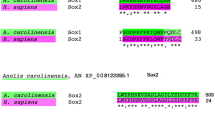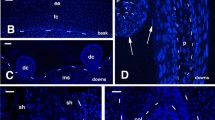Summary
Skin sulfhydryl oxidase (SSO) was prepared from cow snout skin. Dithiothreitol was the thiol substrate most efficiently utilized, with 2-mercaptoethanol, glutathione, and cysteine having less than 23% the relative efficiency of dithiothreitol. In the presence of SSO reductively denatured ribonuclease A was reoxidized and reactivated. The degree of reactivation was proportional to the incubation time and dependent on the amount of enzyme added. The oxidation of thiols by SSO required molecular oxygen as an oxidant. The oxygen consumption increased linearly with the increasing concentration of SSO during the increasing formation of disulfide from sulfhydryl groups. The activity of SSO was detected in differing amounts in each of the four layers — stratum corneum, stratum granulosum, stratum spinosum with basal cell layer, and dermis — of cow snout skin, while showing the highest specific activity in the stratum granulosum.
Similar content being viewed by others
References
Chang TSK, Morton B (1975) Epididymal sulfhydryl oxidase: a sperm-protective enzyme from the male reproductive tract. Biochem Biophys Res Comm 66:309–315
Freedman RB, Hawkins HC (1977) Enzyme-catalyzed disulfide interchange and protein biosynthesis. Biochem Soc Trans 5:348–357
Haber E, Anfinsen CB (1962) Side-chain interactions governing the pairing of half-cystine residues in ribonuclease. J Biol Chem 237:1839–1844
Hawkins HC, Freedman RB (1976) Thiol-protein disulfide oxidoreductases. Biochem J 159:385–393
Janolino VG, Swaisgood HE (1975) Isolation and characterization of sulfhydryl oxidase from bovine milk. J Biol Chem 250:2532–2538
Kalnitsky G, Hummel J, Dierks C (1950) Some factors which affect the enzymatic digestion of ribonucleic acid. J Biol Chem 234:1512–1516
Kissane JM, Robins E (1958) The fluorometric measurement of deoxyribonucleic acid in animal tissues with special reference to the central nervous system. J Biol Chem 233:184–188
Lowry OH, Rosebrough NJ, Farr AL, Randall RJ (1951) Protein measurement with the Folin phenol reagents. J Biol Chem 193:265–275
Ogawa H, Taneda A, Kanaoka Y, Sekine T (1979) The histochemical distribution of protein bound sulfhydryl groups in human epidermis by the new staining method. J Histochem Cytochem 27:942–946
Takamori K, Thorpe JM, Goldsmith LA (1980) Skin sulfhydryl oxidase. Purification and some properties. Biochim Biophys Acta 615:309–323
Author information
Authors and Affiliations
Additional information
Supported by a Grant-in-Aid for scientific research from the Ministry of Education, Science and Culture of Japan (Nos. 58570459, 59770744, 60770812)
Rights and permissions
About this article
Cite this article
Yamada, H., Takamori, K. & Ogawa, H. Localization and some properties of skin sulfhydryl oxidase. Arch Dermatol Res 279, 194–197 (1987). https://doi.org/10.1007/BF00413257
Received:
Issue Date:
DOI: https://doi.org/10.1007/BF00413257




